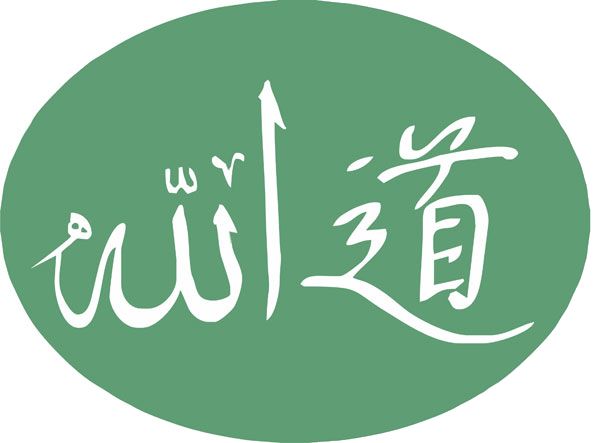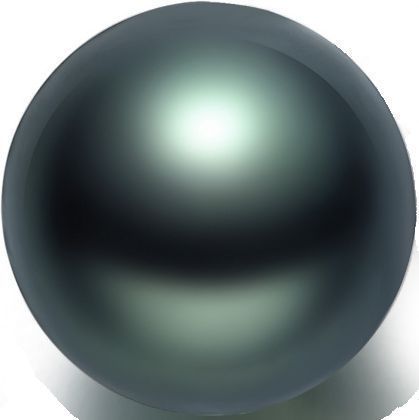POSTSCRIPT to The Black Pearl
[NOTE: This Postscript is work in progress, and will be updated from time to time. HB]
(Last updated: Oct. 1, 2015)
[Allah (“God,”Arabic, left) and Tao
(“the Way,” Chinese, right) combined to form Allah-Tao or “the Way of God” (sunnat-Allah).]
The “Black Pearl” or “Dark Pearl” (xuan zhu) is a symbol for the mysterious Way (Path). As the Turkish Sufi poet Harabi says, “[Only] the Wise understand this shadowy secret.” The mellow, hazy reflections from the surface give the appearance of seeing “as through a glass, darkly.” The perfection of its spherical shape reminds us of another perfection: that of God. (“God is an intelligible sphere whose center is everywhere and whose circumference is nowhere.”)
Shortly before Black Pearl went to
press, my publisher called me long distance. What was the driving idea behind
the book, he wanted to know.
I said, “Sufism is the culmination of East Asian philosophies.” Indeed, this
had been expressed, although perhaps less directly, in the book (p. xxxii).
“What kind of culmination?” he asked. I was taken aback, for it was not
immediately clear to me what he meant. Sensing my uncertainty, he clued me in:
“Historical, metaphysical…?”
“Metaphysical,” I replied without hesitation. This is indeed the main thesis of
the book. Toshihiko Izutsu had already made a start on this when he linked
Sufism with Taoism. Nevertheless, the case had not yet been made for East Asian
philosophies and religions as a whole. Having received a scientific training, I
was concerned that the hypothesis should have predictive power: that it should
hold up not only in cases mentioned in the book, but also in cases yet to be
accounted for. Karl Popper had earlier explained that a scientific claim should
be falsifiable; that it should be
testable against further evidence. Hence, it was important that the hypothesis
should prove to be true in the future, as well.
The Appendix on how to perform the Formal Prayer (namaz, salat) was not originally in the book. As it was being
prepared for publication, an editor suggested the inclusion of such an
appendix, the publisher agreed, and about two months before the publication
date, I duly prepared it. When I came to the part where an extra chapter from
the Koran is recited, I used the Chapter of Unity/Sincerity (Ch. 112), because
of its importance and brevity.
In that chapter, the term lam yulad
occurs. This is usually rendered as “has not been begotten,” but since I was
looking for a concise and preferably poetic term, I used “Unborn.”
As the deadline neared, I was looking at various texts to double-check the
material in the book. Then, in an article about Dogen (13th century AD), I came across the term Dogen used for the Absolute or the
Buddha-nature. It was “Unborn.”
I took this as a vindication and a very auspicious sign. A sacred verse,
recited universally by Moslems during Formal Prayer, was using the same
expression as the Japanese Zen Buddhists! Hence, it was with a sense of
gratification on my part that the book went off to the printers.
I subsequently discovered that the 17th century Zen master Bankei had likewise
used “the Unborn” (Jp. fu-sho) to
refer to Ultimate Reality: “All things are perfectly resolved [all dualities
transcended, all problems solved] in the Unborn.” And of course, it was the
Buddha who first used the term. In the aptly-named Nirvana Sutra, the Buddha says: “There is, monks, an unborn, an
unbecome, an unmade, an unfabricated” (Udana,
8.3; the term also occurs in the Heart Sutra). God is the Maker, the Creator of
all things, yet He Himself is not made, not fabricated. This links in with the
state of la taayyun (indetermination,
the state of being unconditioned) in Sufism. Likewise, He is “the Undying” (Jp.
fu-metsu).
So the main hypothesis of the book still stands. Another example of this is
Rinzai (Lin Chi in Chinese), a predecessor of Bankei. A term made famous by him
is “the True Man of no rank,” which of course refers to the Perfect Man of
Sufism. In an earlier book, The Station
of No Station, I quoted from the Sufi poet Niyazi Misri: “The People of
Truth possess no signs” (p. 193). The title of the book itself refers to Ibn
Arabi’s expression, maqam-al la-maqam,
which in Lin Chi’s terms would mean “the rank of no rank.” *
* * In what
follows, I shall try to tie up some loose ends of the book, add short notes,
and introduce some subjects for further investigation. l One of these concerns Chuang Tzu. One thing I
intentionally omitted from the book is his famous dream of being a butterfly.
When he awoke, he no longer knew if he was a butterfly dreaming he was a man,
or a man who had dreamed he was a butterfly. Although this has obvious tie-ins
with Ibn Arabi’s (not to mention the Prophet’s) concept of the world being a
dream, I did not include this precisely because it is so well-known. l The Chinese term “knowledge-of-no-knowledge” has
its ready correlate in the Sufi saying: “Forget all you know—transform your
knowledge into ignorance.” Mirror, Sword, Jewel The mirror, the sword, and the jewel are ancient symbols coming from
the Japanese creation myths. They are also known as the Imperial Regalia of
Japan or the Three Sacred Treasures of Japan. The sword stands for valor, the spirit, and wisdom. The
mirror stands for wisdom, justice,
the soul, and the Sun-Goddess. And the jewel represents benevolence. Sometimes, a sphere replaces the jewel. Rice-cakes (Kagami Mochi)
are made in the circular form of mirrors, and breaking them during the
"Mirror Opening" (Kagami Biraki)
celebration symbolizes the emergence (from a cave) of the Sun-Goddess in
Japanese mythology. The act is symbolic of renewal, a fresh start, and is a
cause for optimism in the new year ahead. Let us now try to interpret the Three Treasures from the standpoint
(and lore) of Sufism. What can we say about these symbols from an Islamic/Sufic
point of view? When we look in a mirror, we see ourselves—that is, our
“selves.” Hence, the mirror is representative of the self. But a dirty or
cloudy mirror will not reflect the light of the Spiritual Sun, which is our
Source, properly. Hence, self-purification is in order. We must cleanse the
mirror of our self. The mirror also symbolizes the Heart Center, for our
spiritual Heart, when polished, reflects the light of the Divine. The Prophet said, “He who knows his self knows his Lord.” As we
purify ourselves, the later accretions which are not essential to us will be
removed, until the mirror is spotless. This we will achieve by refraining from
the two no-no’s (illicit gain and illicit sex), plus doing the one
yes-yes (performing the Formal Prayer). When the process is culminated, we will
see a reflection of our true self, which is the Self, in the mirror. That will
also be our face before we were born. The rice-cake of our old self will
split—our mirror will be opened (fath)—and
will make way for the Sun to come out from the cave of our old self. That is
when we will truly come to know our Essence. (“The Essence of the Real, know this, is your essence.” —Niyazi
Misri.) But this is no easy task. It means great spiritual struggle, and
this is where the sword comes in. We must actively “struggle with our
possessions and our selves” in order to purify the self. The sword is used to
slay the dragon of the Base Self. It also symbolizes the spirit and its
strength, as well as its life-force, held within the “sheath” of the body. The jewel, or the sphere, symbolizes the fruits of our struggle. A
jewel is something of great worth, while a sphere represents geometrical
perfection. The sun itself is spherical, and so are pearls. (For more on the
symbolism of the sphere, see “2001, 3001, and the Cube” in the collection Science, Knowledge, and Sufism.) That is, we will have become a Perfect Human Being (insan al-kamil), a self-made work of art
that is as rare and priceless as a jewel. And even if we do not make the
highest grade, we will still be rewarded with the jewels of Paradise, for not a
single step along this path is lost or wasted. Titus Burckhardt states that the mirror is a fitting symbol for the essence of mysticism: “it portrays the union of subject and object.” I quote from his essay, “The Symbolism of the Mirror” (in the anthology The Mirror of the Intellect):
According to a saying of the Prophet Mohammed, there is ‘for every thing a means of polishing it and freeing it from rust. One thing alone polishes the heart, namely the remembrance [Invocation] of God (dhikr Allah)’. The heart, centre of the human being, is therefore like a mirror, which must be pure, so that it may receive the light of the divine Spirit.
Just as it is in the nature of a mirror to shine, so all beings at their origin possess spiritual illumination. When, however, passions obscure the mirror, it becomes covered over, as if with dust. When false thoughts, under the direction of the master, are overcome and destroyed, they cease to proclaim themselves. Then is the Intellect illumined, in accordance with its nature, and nothing remains unknown. it is like the polishing of a mirror... (Tsung-mi)
This passage might equally well have come from a Sufi treatise.
Calligraphy
Another subject that could have been included in the book concerns
Chinese/Japanese calligraphy on one hand and Arabic calligraphy on the other. A
comparison between these had to await this writing.
One may perhaps begin by stating the main difference: East Asian calligraphy is
based on ideograms, or “thought-pictures,” while Middle Eastern calligraphy is
based on letters of the alphabet. To the extent that the letters can be said to
embody a thought or concept, this is achieved only through their combination.
As Toshihiko Izutsu has pointed out in his immensely informative Toward a Philosophy of Zen Buddhism
(1977), Japanese painting and calligrahy reduce all colors to the basics: black
and white, 0 and 1. In the final chapters of the book, Izutsu tells us that the
white, unmarked canvas quite intentionally represents the Undifferentiated
Absolute, while the black markings on it are intended to represent the myriad
specific forms that emerge from the Absolute. Another characteristic of Chinese
calligraphy is that details of the brush strokes which compose an ideogram
embody the state of mind of the artist. So, an observer, after long
contemplation, can achieve exactly the same state, at which point a “meeting of
mind with mind” occurs where the artist and the observer are one via the
identical state. This is reminiscent of the spiritual rapport between the
master and disciple in Sufism.
While Middle Eastern calligraphy is not pictorial, the letters are often
arranged to depict a picturesque form. This can be anything: a ship
(representing Noah’s Ark), a bird (representing angels or the power of flight),
a human face. The cover of my first book, The
Station of No Station (2001), shows the Arabic script of “There is no
god but God, and Muhammad is the servant and Messenger of God” in the form of a
human being (a true homo Islamicus).
Furthermore, the Names of God (beginning with the most famous one, Allah) are considered to hold the power
of the Presence of God, so that visualizing the name of God in the Heart can
lead to a Vision of God (ruyat Allah).
(This need not be in Arabic alone: for example, the same result can be achieved
by visualizing “Allah” inscribed in Latin characters in the Heart center.) 

To this may be compared the following teaching from Northern or Ch'an Buddhism: